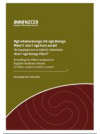Part of experiencing success as Māori within schools depends on having opportunities to learn and use te reo Māori and tikanga Māori. But how well do we provide for Māori students in English-medium schools? This report looks at whether provision differs in relation to the level of Māori enrolment in a school, using data from NZCER's National Surveys of primary and intermediate schools in 2013, and secondary schools in 2012. The report concludes that the level of Māori enrolment in a school does make a difference to the learning opportunities Māori learners are able to access.
Key Results
Ngā kitenga matua—Main findings
On the whole, the level of Māori enrolment in a school does make a difference to the learning opportunities that Māori learners are able to access.
Māori learners are more likely to have opportunities to learn te reo Māori in schools with high Māori enrolments. However, connections were uncommon between early childhood education services and primary and intermediate schools, and between primary and intermediate schools and secondary schools (in Māori and English mediums) that support reo Māori learning continuity at higher proficiency levels. This has implications for how well schools are prepared to support reo Māori learning.
In schools with high proportions of Māori, Māori learners were more likely to experience aspects of their culture through school-wide practices. Learners in schools with low proportions of Māori were less likely to experience the same cultural opportunities.
Many Māori parents had positive attitudes towards the ability of their child’s school to be culturally responsive. However, there were still parents who would like to see improvements in— or have more information about—this aspect of their school’s practice.
More research into what schools are doing to integrate Māori culture into their school-wide practices would be useful to show how practices differ between schools. This could help schools to share knowledge with one another.
Schools are paying attention to progressing their relationships with whānau and iwi, and are undertaking professional learning and development, particularly in primary schools, to help strengthen these relationships. However, schools with high proportions of Māori learners are more likely to have trouble accessing support to help them better engage with whānau about student learning at school and at home. Arguably, these are the schools that most need that support. Ensuring that schools are able to access appropriate professional development programmes and resources remains an important means of supporting schools to build their capabilities in this area.
Many principals, particularly in secondary schools, reported gains for Māori students among their main achievements for the past 3 years. Schools are paying attention to their Māori students, and schools with high proportions of Māori learners are more likely to have a focus on Māori achievement. Achievement is more likely to be viewed as a major issue in secondary schools than in primary schools, but the need for professional learning and development to support better engagement of Māori students in learning is not being met in both primary and secondary schools.

